Document Version Control with GIT
Before we start…
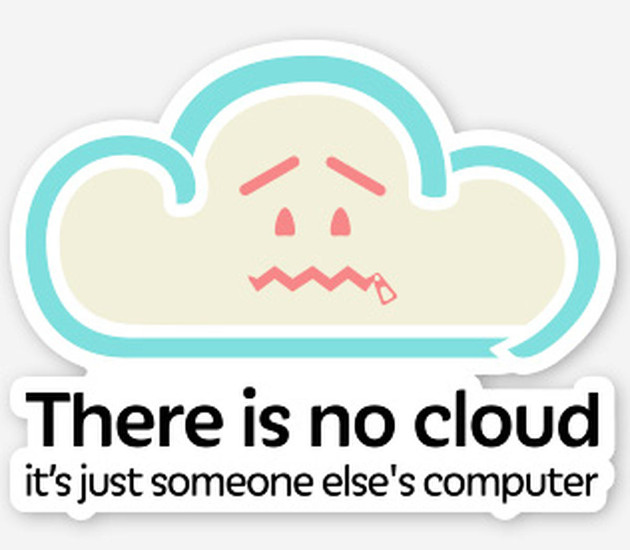
What is version control?
Version control is a system that records changes to a file or set of files over time so that you can recall specific versions later.
Has existed for almost as long as writing has existed (ex. document version)
Today, the most capable (as well as complex) revision control systems are those used in software development.
Why?
Revert files back to a previous state
"Freeze" important versions of a document
Compare changes over time
Track progress of a project
See who modified something, and when
Modern version control systems
Remote backup of files
Powerful tool for collaboration
GIT
Developed by Linus Torvalds in 2005
The linux Kernel:
~63000 files
Roughly 15,600 developers from more than 1,400 companies
Characteristics
Free and open source
Distributed
Powerful and flexible
Learning curve can be steep
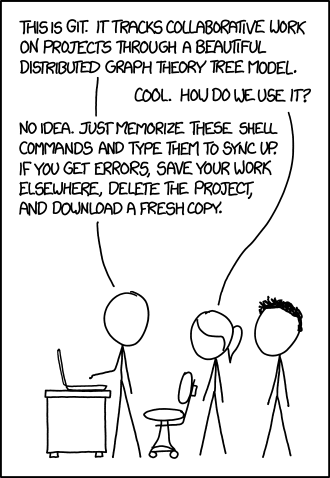
How does it work?

Installation
Package managers are heavily recommended!
Creating a remote repository
register at the remote git server
create repository
add participants ssh public keys
clone the repository in your machine
README and .gitignore
Every repository should have these 2 files:
README: project description and useful information
.gitignore: special file indicating GIT which files are not to be tracked
workflow
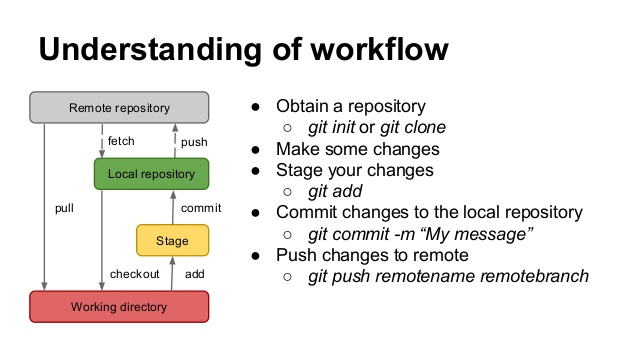
copying remote repository: clone
git clone repository
Clones the remote repository into the local one
staging changes (local)
git add files
Adds the changes into the local staging area
Saving changes: commit (local)
git commit "message"
Saves the changes in the staging area into the repository
Creates a "snapshot" of the current state of one or more files
A message describing the changes must be provided
history and revert (local)
git log files
returns a history of the file modifications
git revert commit
removes one or more commits from the local files, changes must be committed after
upload to remote repository: push
git push
Uploads the state of the local repository to the remote one
Download from remote repository: pull
git pull
Fetch and merges the documents in the remote repository into the local one
Merging files can generate conflicts, git will ask us to fix them and commit the changes
Branching
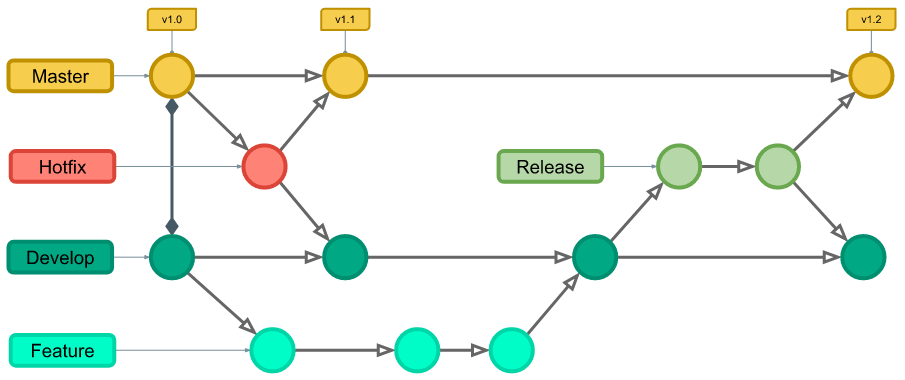
other (advanced) stuff
tags
partial reverts
change history
…
Docs as code
Software is a small part of the documents a project must handle
Still, version control and remote collaboration are needed for all the documents
In the last years there is a big push of treating documents the same way as programming files
Advantages
Working in plain text files (rather than binary file formats like Word)
Collaborating using version control such as git and GitHub
Storing docs in the same repositories as the programming code itself
Versioning docs through git tags/releases (rather than duplicating all the files to archive each release)
Generate other formats or websites without modifying the document
Just a little problem…
The most common document formats: word, pdf… are binary files
git (text based) doesn’t work with them
Solutions?
Markup languages:
Markup languages are ways of annotating an electronic document.
Usually markup will either specify how something should be displayed or what something means.
html, xml, latex…
Markup languages
Documents are written in plain text, then a program convert them into the final document
The same document can be used to generate files in other formats: latex, word, pdf or even slides
Formating is done by the computer, output is always consistent
Fast and light
Can be used in version control systems
Markup languages: Advanced features
Automatic generation of documents
Inline comments (not rendered in the final document)
Split one the document into several. Ex: main document, chapters and bibliography
Code executed and plots rendered in the document
Latex
Extensively used for technical papers
Beautiful generated documents
Very powerful…
…and very heavy
Setup and document customization are complex
Latex: example
\documentclass{article}
\usepackage{graphicx}
\begin{document}
\title{Introduction to \LaTeX{}}
\author{Author's Name}
\maketitle
\begin{abstract}
The abstract text goes here.
\end{abstract}
\section{Introduction}
Here is the text of your introduction.
\begin{equation}
\label{simple_equation}
\alpha = \sqrt{ \beta }
\end{equation}
\subsection{Subsection Heading Here}
Write your subsection text here.
\begin{figure}
\centering
\includegraphics[width=3.0in]{myfigure}
\caption{Simulation Results}
\label{simulationfigure}
\end{figure}
\section{Conclusion}
Write your conclusion here.
\end{document}Latex: example II
\documentclass[12pt]{article}
\usepackage{lingmacros}
\usepackage{tree-dvips}
\begin{document}
\section*{Notes for My Paper}
Don't forget to include examples of topicalization.
They look like this:
{\small
\enumsentence{Topicalization from sentential subject:\\
\shortex{7}{a John$_i$ [a & kltukl & [el &
{\bf l-}oltoir & er & ngii$_i$ & a Mary]]}
{ & {\bf R-}clear & {\sc comp} &
{\bf IR}.{\sc 3s}-love & P & him & }
{John, (it's) clear that Mary loves (him).}}
}
\subsection*{How to handle topicalization}
I'll just assume a tree structure like (\ex{1}).
{\small
\enumsentence{Structure of A$'$ Projections:\\ [2ex]
\begin{tabular}[t]{cccc}
& \node{i}{CP}\\ [2ex]
\node{ii}{Spec} & &\node{iii}{C$'$}\\ [2ex]
&\node{iv}{C} & & \node{v}{SAgrP}
\end{tabular}
\nodeconnect{i}{ii}
\nodeconnect{i}{iii}
\nodeconnect{iii}{iv}
\nodeconnect{iii}{v}
}
}
\subsection*{Mood}
Mood changes when there is a topic, as well as when
there is WH-movement. \emph{Irrealis} is the mood when
there is a non-subject topic or WH-phrase in Comp.
\emph{Realis} is the mood when there is a subject topic
or WH-phrase.
\end{document}Latex alternative: Lyx
WYSIWYG latex editor
Documents are generated in .lyx, a subset of latex
Can be used together with version control
Provides, by default, templates for many of the biggest scientific journals
Lyx: example
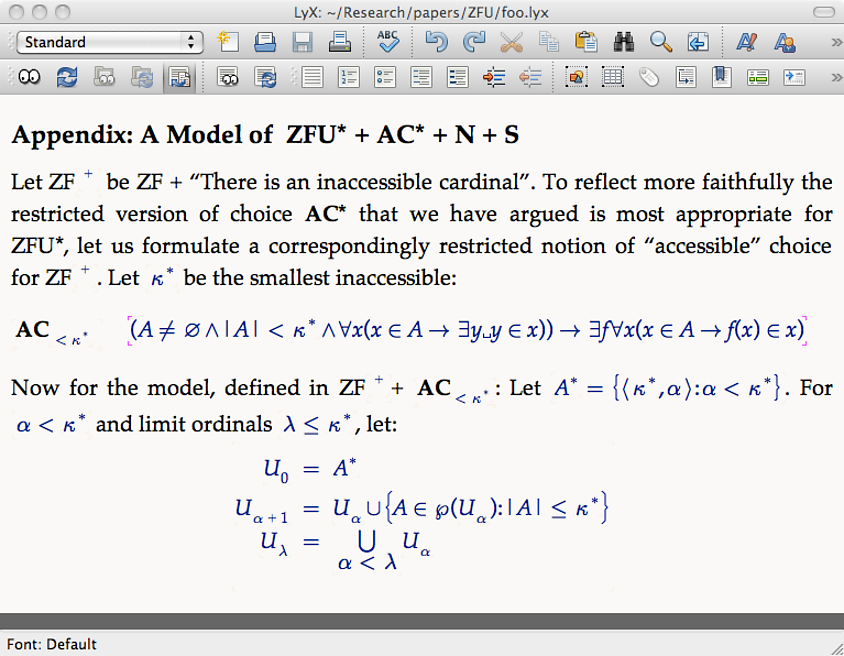
Lyx: example II
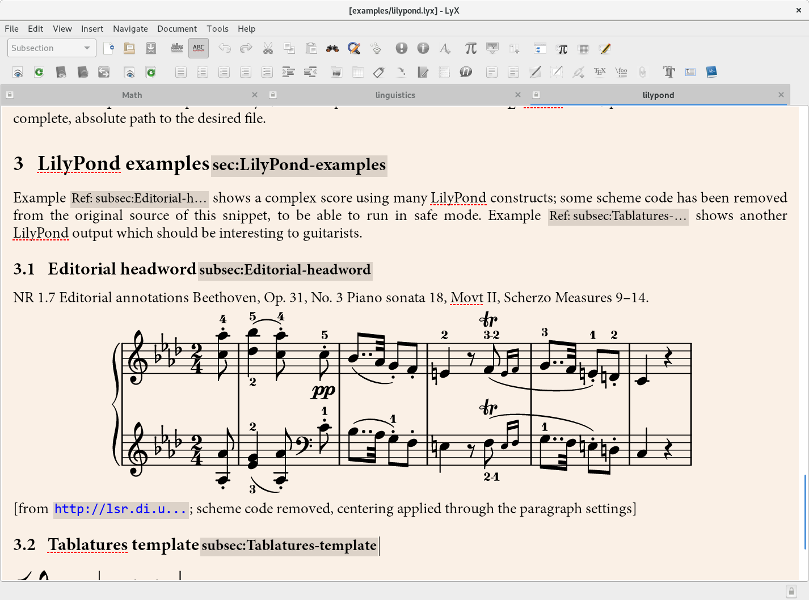
Lightweight Markup languages
Also called Plain Text Markup or humane markup language
Provide a way of formating the document, while still being readable
Widely used on websites and code documentation
LML: current options
Markdown
reStructuredText (rst)
Asciidoc
Markdown
Created for minimal formating of web text
used everywhere: web, jupyter notebooks, r-markdown…
There is no standard, currently exist many flavours of it (github, commonmark, pandoc)
Originally not intended for documents, very limited
Different flavors and tools try to overcome this limitation
(+ pandoc)
Markdown: example

Asciidoc
Developed for book creation.
Limited number of users
Standardized and extensible, great documentation
Lack of resources makes that bugs or request take time to be fixed
reStructuredText
Originally intended for python documentation
medium sized but very tech-savvy community
Syntax is a little different than the other two
Very powerful and extensible
Which one to use?
Notetaking:
Markdown
Asciidoc
reStructuredText
Anything more serious:
reStructuredText
Latex/Lyx
Resources
choco install git vscode pandoc